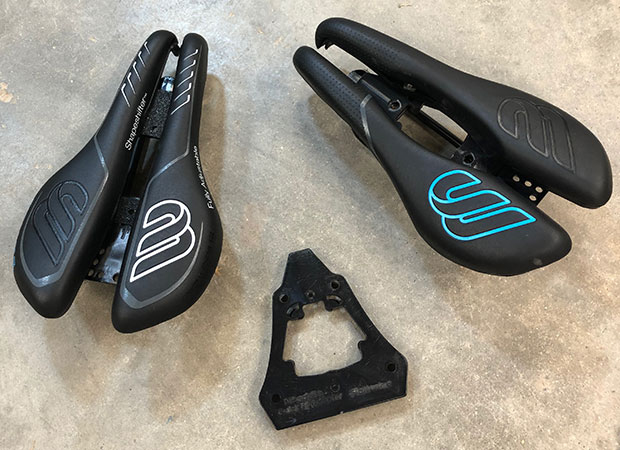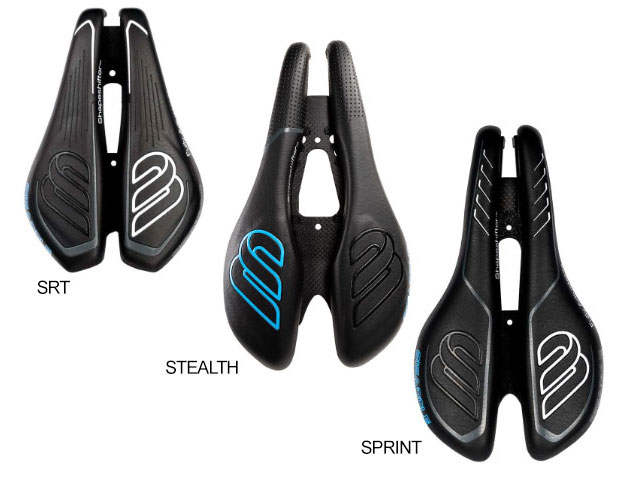There’s a short video below that shows a little of the function of this saddle, and what you get when it comes in the mail. In it, I refer to the BiSaddle as a “new” saddle and that’s not entirely accurate. It’s been around a couple of years, but it’s only starting to gain notice among triathletes recently.
We’ve written about this saddle several times. We first noticed it in this article, more than 2 years ago. Our man Greg Kopecky wrote a fairly in-depth piece on it about a year and-a-half ago, but if you migrate to the bottom of that article you’ll see a 2019 update, with new saddle rails, and a new, sleeker look. That saddle is pretty close to what I’m writing about today.

The saddle seems to have arrived at a point where the visuals – the appearance of the saddle – and the functionality, and the recognition of a need on behalf of the consumer, conspired to give this product it’s “moment”.
For those who don’t know, this saddle consists of halves, which sit on a chassis, and this allows the “nose” of the saddle to be adjusted more narrowly, or wider. Same with the rear of the saddle, in the flange area. There are 4 screws on the saddle’s underside – 2 fore, and 2 aft – that, when loose, allow the saddle’s halves to be adjusted.

The top of the chassis on which the two halves of the BiSaddle sit is now covered with a friction surface. The folks who make this saddle have been updating it at a rate of about once every six months, or that’s the pace at which I’m noticing updates.
I keep saying BiSaddle but there are 3 models now, and that’s of the upper. That doesn’t count the rail options, which at this point are chrome moly, titanium and carbon. Parenthetically, I don’t know that I’m a big fan of titanium as a saddle rail option. Carbon maybe. But if the weight of chrome moly rails bothers me, maybe I should just push the plate away when I’m full instead of stuffed.

I write about this saddle in the context of “Fix It!”, our little focus on fixing problems that ail you as we transition from indoor cycling to outdoor. (Here is the discussion on our Reader Forum where we dig in to fix your particular issue.) This is pretty much my process for making changes, especially if they refer to position or contact point tenderness. I first get used to it on the trainer, then I take it outside. For example, I’m writing about Shimano shoes upcoming, the RC8 and the RC9. First I ride a bunch of indoor rides with them. I get the bugs out. Are they the right size? Are the cleats adjusted right? Are they wedged right? (If they’re wedged.) Then I take them outside. Same with saddles and saddle position.

This saddle is a candidate for that process, because you’re going to have to stop several times to get the adjustment right, so, you can hop off your bike when it’s on the trainer, make and adjustment, get back on and ride, or you can get off your bike on the side of the road, perhaps with the tools you need, perhaps not. I find it much easier to fix those issues indoors, with my tools at hand, in a climate controlled area, with the bike either in the stand or stood up on the trainer. I’m more comfortable sacrificing a 60-minute indoor ride with 5 or 6 stops inside of that hour-long ride, than suffering this process outdoors.

Why is this saddle going to take you this long to adjust? Because of all the adjustments available to you. You have nose width and flange width to contend with. You have the roundness of the saddle, that is, the top of the saddle is flat, slightly concave, or more concave. Then there’s saddle fore/aft adjustment.
It’s going to take you awhile. And, about that concavity part, if you don’t solve this while indoor cycling you’ll have to bring those two optional plates with you on your outdoor ride (see the video).
These saddles weigh more than other saddles. Right? Well, they sure should way more. But they don’t. The saddles range in weight from about 275g to 350g, but it’s quite common for typical split nose tri saddles to weigh between 280g and 400g.
These saddles are semi-expensive at the low end, and quite reasonable at their high end. They range from $230 to $350, and at $230 that’s a bit pricey. But $350 for the carbon chassis saddle is really not pricey, compared to other saddles built with like materials. I bring up the price because that’s a lot of money to spend on a maybe, and saddles are – let’s face it – a maybe. You’re taking a risk. So, this company offers a 90-day money back guarantee, and if you don’t like the saddle you have two responsibilities: it can’t be damaged when you return it; and you must pay the shipping back to BiSaddle. That's quite a long time during which you can figure out if this saddle's a good match.



